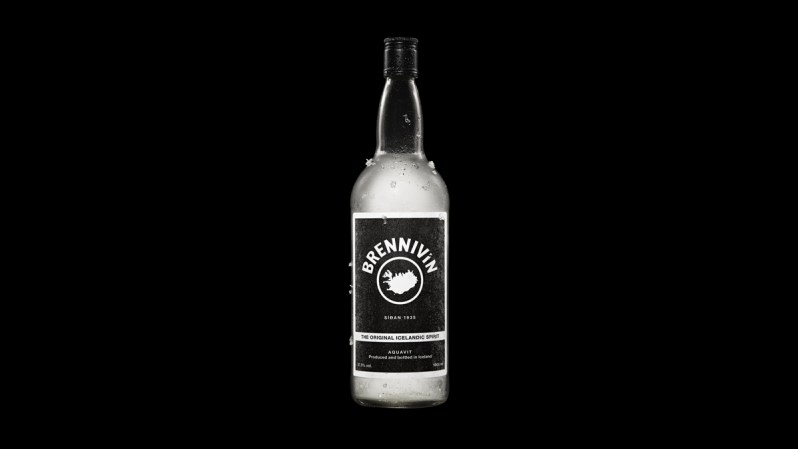If you think you know your Scandinavian aquavits, think again. Brennivín is an Icelandic spirit that is slowly winning over hearts and palates in American bars. Given that it has only been available in the U.S. since 2014 and its small batch nature, Brennivín’s growing popularity is a testament to liquor itself.
Joe Spiegel, founder of Brennivín America, is the exclusive importer of this coveted beverage. His friends and bar owners fell in love with the bottles of Brennivín he would bring back from his trips to Iceland. Realizing there was a market for traditional aquavits in the U.S., Spiegel set out on a two-year-long mission to bring Brennivín to bars and liquor stores across the country, finally succeeding in 2014.
What Is Brennivín?
Made from grains/potatoes, depending on country-specific regulations, aquavits (or akvavits ) are sources of national pride throughout Scandinavia. Aquavits are clear liquors commonly compared to gin, but typically boast caraway and dill as opposed to juniper berries. Their popularity abroad has led to many American versions of the spirit, but many still crave the real deal.
Brennivín only uses caraway seeds for flavor (though some special versions used angelica or wormwood as well, the latter presenting as a more approachable Malört), but its subtle sweetness stems from the Icelandic water used. With a pH of about 8.9 and lack of limestone present in the water, most native Icelandic drinks take on a distinctive flavor profile.

The first and main spirit of Iceland, Brennivín was introduced to the public in 1935 when the government partially repealed prohibition. The stark label (which has only been slightly modified for legal reasons) was created to appeal to the temperance movement, but its design inadvertently drew more people to it. Colloquially known as the “black death,” due to the label and the Icelandic slang for drunk literally translating to “dead,” the clear spirit has been “killing” Icelanders for decades.
To this day, Brennivín is typically served neat and cold (re: nearly freezing) to the point where it has a very viscous mouthfeel, but it was often used for beer cocktails. Before the full repeal of prohibition in 1989, beer was still illegal, so locals would often pour a shot of Brennivín into a non-alcoholic beer. Though alcohol consumption and advertising is still heavily regulated, the floodgates have opened and so have the craft cocktail uses for the spirit.
How Do You Drink Brennivín?
Like most aquavits, the easiest way to think about Brennivín is as a gin replacement, but it also works well in lieu of white rum and…rye whiskey. You can make gin cocktails less sweet and whiskey cocktails more palatable with a simple switch.
“Brennivín kind of tastes like what you always imagined rye whiskey is going to taste like and it never does,” laughed Spiegel as he explained his beloved Brennivín Old Fashioned in which the akvavit replaces half of the whiskey. “The taste of rye bread is actually the caraway seeds.”
Before you start experimenting with Brennivín, you should probably get used to having it neat. Walking the line between sweet and savory, in addition to its texture, the cocktail possibilities are endless and only dependent on your personal preferences.
“Being single botanical is very helpful because we’re a building block spirit,” said Spiegel. “It provides a unique herbal but savory flavor, so folks who come at it from a culinary background enjoy working with Brennivín.”
If you’re not particularly imaginative when it comes to cocktails, here are a few tried and true Brennivín elixirs to get you started:
Black Rose
Jeff Grdinich, The Rose, Jackson Hole, WY
- 1 ½ oz Brennivín
- 1 ¼ oz Lillet Rose
- ¼ oz Kina D’Avion d’Or
Method: Stir ingredients together. Strain into coupe glass.
Stone Crush
Chaim Dauermann, Up&Up, NYC
- 1½ oz Brennivín aquavit
- ½ ounce Dolin Blanc vermouth
- ¼ ounce Rabarbaro Zucca amaro
- 1 ounce Stiegl Goldbräu pilsner beer
- 1 cucumber, sliced
- 1 lemon
Method: In a mixing glass, muddle three or four slices of cucumber into a juicy pulp. Fill the mixing glass with ice, then add the Brennivín, vermouth and Zucca. Stir well. Lastly, add the Stiegl beer. Strain the drink through a fine-mesh sieve into an ice-filled rocks glass. With a paring knife or peeler, cut off a strip of lemon peel and twist it over the drink to express the lemon oil. Discard the peel. Garnish with more slices of cucumber and serve.
Arctic Solstice
Villi K., B5, Reykjavik
- 2 oz Brennivín
- 1 oz Chambord or Chateau Monet Creme Framboise
- 1 oz Fresh squeezed lime juice
- Soda water
Method: Shake with ice. Strain into a Collins glass and top with soda water to fill. Garnish with mint sprig and slice of grapefruit.
Feature Image Courtesy of Iceland Naturally


